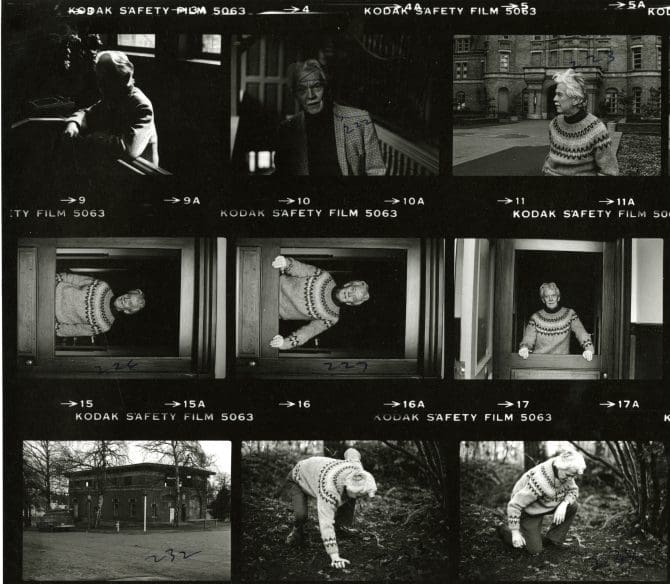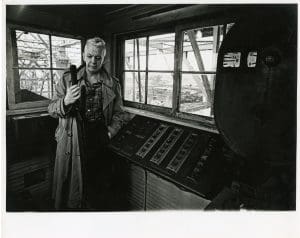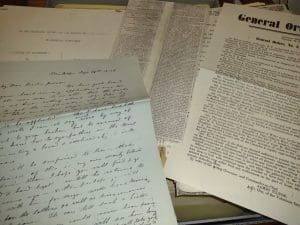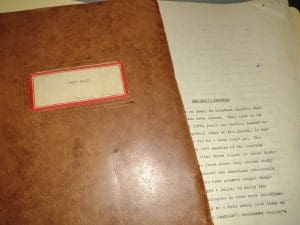The Northwest Room is very pleased to announce that the Murray Morgan Papers are now available to users, opens a new window! Morgan's work as a historian, writer, journalist, broadcaster, and teacher is revealed through these personal papers which include drafts and manuscripts of his books, articles, and unpublished writing projects; research files assembled by Morgan and containing clippings, reports, notes, and writing drafts; teaching materials such as lesson plans and lecture notes; photographs used in Morgan's publications or related to research topics; transcripts and notes from Morgan's radio broadcasts; audio and video recordings; personal materials, awards, and ephemera. The full description of the papers, along with a selection of digitized material, is available Northwest ORCA, opens a new window.
With support from a City of Tacoma Heritage Grant, the Northwest Room hired a student to assist with arrangement and description of the papers. Andrew Weymouth, who completed his Masters of Library and Information Science program with the University of Washington iSchool in May 2022, worked on processing Morgan’s papers between December 2021 and March 2022. The materials were physically organized into several topical areas and re-housed in archival boxes and folders. A detailed description was then created and made available online to allow users to determine which parts of the papers may fit their information need.
Many of Morgan's audio recordings are included in his papers and 23 of of his reel-to-reel tapes were digitized as part of this project, opens a new window. Listen to Murray report from the site of a 1952 plane crash near S. 84th Street and South Tacoma Way, opens a new window, interview Washington 6th District US Congressman Floyd Hicks, opens a new window, and even describe in detail the room where he wrote, opens a new window.
The name Murray Morgan is one familiar to many Puget Sound residents. Some may recognize Morgan as a writer and historian whose influential books Skid Road: An Informal Portrait of Seattle and Puget’s Sound: A Narrative of Early Tacoma and the Southern Sound captivated readers and shaped the region’s historical narrative. Others may recall seeing Morgan’s byline on theatre reviews and cultural writings or hearing his voice on the radio waves of KMO. Some may have even been enrolled in his course on Pacific Northwest history which he taught at Tacoma Community College from 1969 to 1981. Still others may recognize him as the namesake of the Murray Morgan Bridge which spans the Thea Foss Waterway.
Born in Tacoma in 1916, Morgan’s first piece of writing was published in a national magazine before he had even graduated Stadium High School. He enrolled at the University of Washington where he studied journalism and edited the UW Daily. He graduated cum laude in 1937 and then moved to Hoquiam to report on sports and local news for the Grays Harbor Washingtonian. He briefly returned to Seattle to edit the Seattle Municipal News. While there, he reunited with Rosa Northcutt, who had also attended UW and worked on the UW Daily. On March 5, 1939, Murray and Rosa were married in Tacoma. The couple went to Europe for their honeymoon where they embarked on a kayaking trip through Germany and Austria. Murray's reports on the trip were published in the Tacoma News Tribune. He then wrote for the Spokane Daily Chronicle before returning to the Grays Harbor Washingtonian as the City Editor.
In 1941, he moved to New York City to pursue a Master's degree in journalism at Columbia University. After the attack on Pearl Harbor, media outlets expanded their operations and Murray began working on assignments for CBS, Time, and the New York Herald Tribune. Rosa attended his classes and took notes for him while he wrote. With her help, he completed the Master's program and was awarded a Pulitzer Fellowship. He and Rosa moved to Lake Patzcuaro, Mexico where Murray intended to study and write about the Mexican press. His first book, a mystery called Day of the Dead, was published under the pen name Cromwell Murray in 1946. Just a few months after their arrival in Mexico, Murray was drafted into the army.
While stationed in the Aleutian Islands, Rosa encouraged Murray to write about the history of the islands. She conducted research and sent the information to Murray. This resulted in his first history book, Bridge to Russia: Those Amazing Aleutians (1947). Murray was then transferred to the Pentagon to work as a decoder. While in Washington, DC, he worked with Rosa to research the CSS Shenandoah which resulted in the book Dixie Raider (1948). The Morgans returned to Washington and lived on Maury Island where Murray wrote a second novel, The Viewless Winds. They then moved to Trout Lake where Murray would live for the rest of his life.
He wrote for dozens of magazines and newspapers including Holiday, Esquire, Cosmopolitan, The Nation, and the Saturday Evening Post. He also worked as the copyeditor for the Tacoma Times and taught courses and advised the student newspaper at the University of Puget Sound. He briefly worked the graveyard shift as the bridgetender for the 11th Street Bridge which would later be renamed in his honor.
In 1951, Murray's most successful book, Skid Road: An Informal Portrait of Seattle was published. In the early 1950s, Morgan added the role of broadcaster to his growing list of occupations. He and Jim Faber co-hosted a morning news program on KMO and then KTAC where they discussed Tacoma politics and became known for exposing corruption. In 1956, Morgan joined KTNT to host a morning program called "Our Town, Our World," which would continue for 15 years. In 1963, he started a regular review column for the Seattle periodical Argus. Between 1969 and 1981, he taught a course on Northwest history at Tacoma Community College. During this period, he also taught at Highline Community College, Pacific Lutheran University, and Fort Steilacoom Community College. Over the course of his career, he wrote or co-wrote 23 books. He died on June 22, 2000.
In a remembrance of Murray Morgan written in 2000, opens a new window, Paul Dorpat described Morgan's influence on regional history by saying, "By the mid-1960s, the still young Morgan was already the 'Dean of Northwest Historians'.... When Murray started producing his well-wrought histories, there were few others in the field. Now it is wonderfully crowded. I suspect that all historians -- popular and academic -- who treat on northwest subjects, will happily confess to have been following 'The Historic Murray Morgan.'"
To view the description of the Murray Morgan Papers and to access digitized content visit Northwest ORCA, opens a new window.






